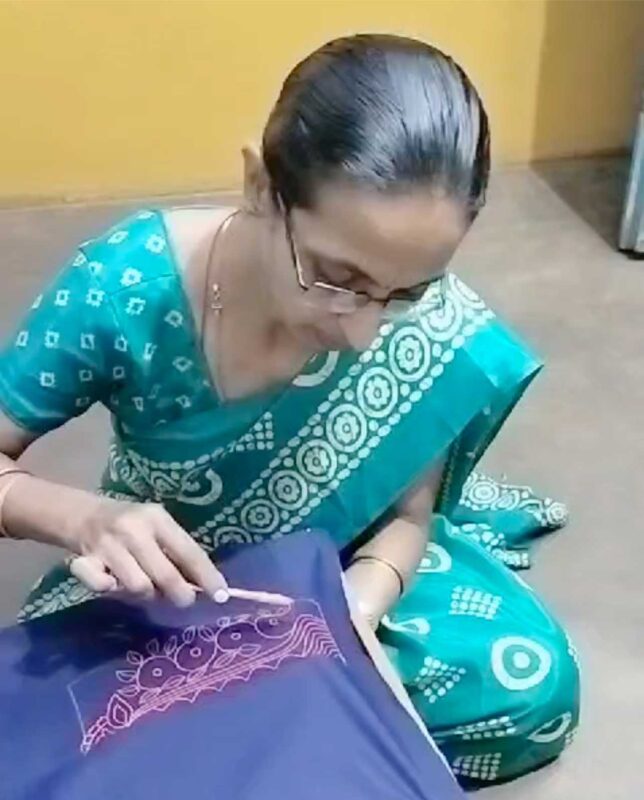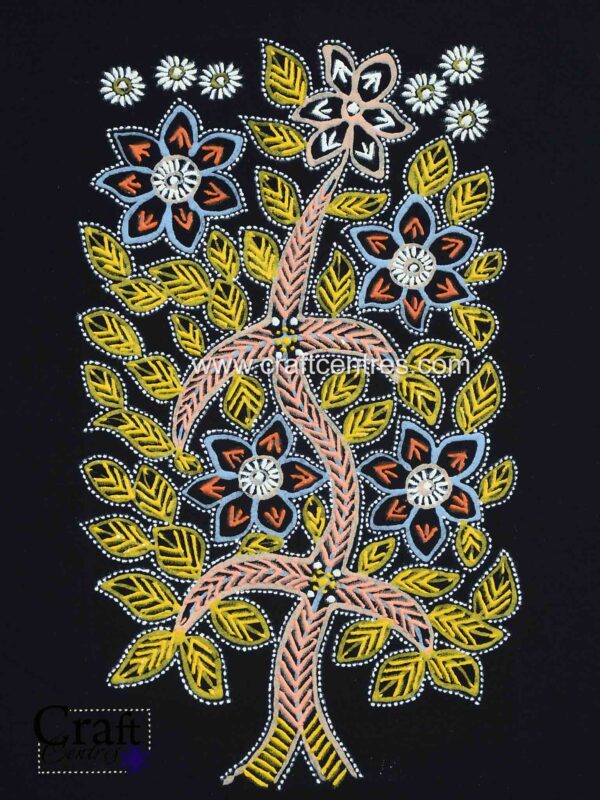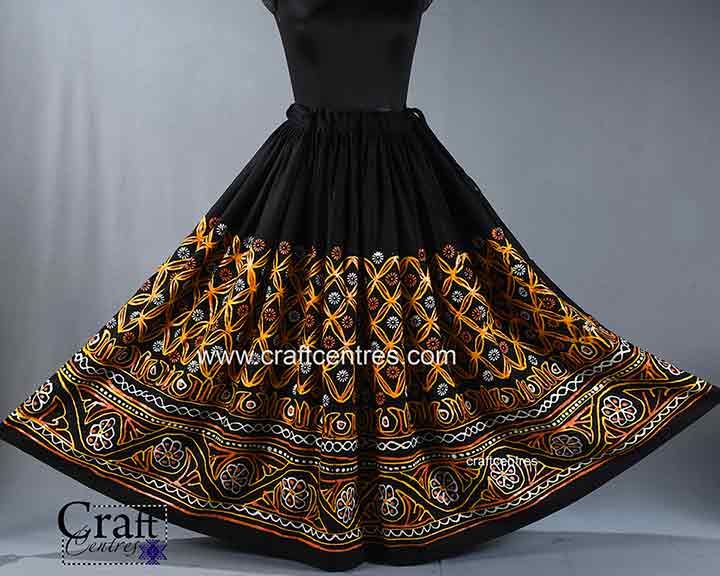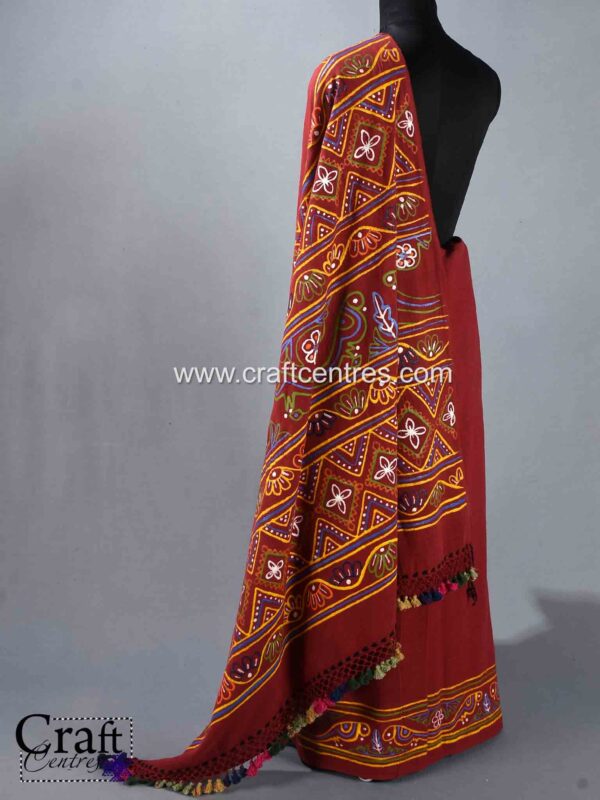In the heart of Moti Virani, Nakhtrana, Kutch, Asmita Soni stands as a pioneering figure in the world of Rogan art. As female artist from her region to master this ancient craft, Soni’s dedication and artistry are helping to ensure that a centuries-old tradition continues to flourish in the modern era.
Rogan Painting: An Ancient Tradition

Rogan painting, a revered craft from Gujarat, India, is not just an art form but a living testament to the region’s rich cultural history. Originating around 1550 years ago, Rogan painting is distinguished by its use of natural oils and pigments to create intricate, colorful designs on fabric. Unlike other painting techniques, Rogan art employs a freehand method where designs are applied to one side of the fabric and then transferred to the other side by folding the cloth. The traditional color palette is limited to five hues—orange, blue, yellow, green, and white—each applied with precision to create vibrant, enduring patterns. This limited palette is a hallmark of Rogan painting, showcasing the artist’s skill in manipulating a few colors to produce complex and beautiful designs.
Asmita Soni: A Modern Maestro of Rogan Art
Asmita Soni’s journey into Rogan art is both inspirational and groundbreaking. Learning the craft from her brother, Ashish Kansara, Soni has not only embraced the tradition but has also become a leading figure in its preservation and evolution. Over the past five years, she has devoted herself to mastering and showcasing Rogan art, becoming the only female artist in India to continue this ancient craft. Soni’s work includes the creation of stunning pieces like the “Tree of Life” Rogan painting. This particular piece exemplifies her skill and dedication, capturing the intricate beauty of Rogan art while reflecting her personal artistic vision. Her contributions are crucial in maintaining the relevance of Rogan art in today’s rapidly changing world.
The Intricate Process of Rogan Painting
The process of creating a Rogan painting is as fascinating as the finished product. The artist begins by preparing a paste made from natural oils and pigments, which is then applied to the palm of the hand. Using an iron rod, the artist carefully transfers the paste onto the fabric in a freehand design. This technique requires immense skill and precision, as the design is mirrored by folding the fabric and pressing it to ensure that both sides match perfectly. Once the design is applied, the fabric is left to dry in the sun. This final step is crucial as it sets the colors and ensures that the painting is durable and vibrant. The entire process reflects a deep understanding of both the materials and the techniques involved, showcasing the artist’s mastery over this ancient craft.
Asmita Soni: Rogan art | Preserving and Innovating

Asmita Soni’s commitment to Rogan art is not just about maintaining tradition but also about innovating within it. By embracing and refining the traditional techniques, she ensures that Rogan art continues to resonate with contemporary audiences while honoring its historical roots. Her efforts are a crucial part of preserving this cultural heritage and ensuring that it remains a vibrant and living tradition. The role of artists like Soni is vital in keeping ancient crafts alive. In a world where traditional skills are often overshadowed by modern technology and mass production, her work represents a bridge between the past and the present. Through her art, Soni is not only celebrating a rich cultural tradition but also inspiring future generations to appreciate and continue these invaluable practices.
The Broader Significance
The significance of Asmita Soni’s work extends beyond the art world. Her dedication to Rogan painting is a reminder of the importance of preserving cultural heritage and the unique skills associated with traditional crafts. As the only female Rogan artist in India, her contributions highlight the role of women in sustaining and advancing cultural traditions. Furthermore, Soni’s work brings attention to the broader narrative of ancient crafts in a global context. The discovery of Rogan art in Bamiyan, Afghanistan, and its recognition by UNESCO underscores the universal value of such traditions. By continuing this craft, Soni plays a part in a larger story of cultural preservation and appreciation.
Conclusion
Asmita Soni’s Rogan art is a shining example of how dedication and artistry can preserve and rejuvenate ancient traditions. Her work with Rogan painting not only celebrates the rich heritage of Gujarat but also showcases the timeless beauty and complexity of this unique craft. As she continues to innovate and inspire, Soni ensures that Rogan art remains a vibrant and cherished part of India’s cultural landscape, bridging the gap between ancient techniques and contemporary appreciation.
Through her artistry, Asmita Soni offers a glimpse into a world where tradition and modernity coexist harmoniously, reminding us of the enduring power of cultural heritage and the importance of preserving it for future generations.
Her Social Instagram Profile @rogan.art_official


Thank you brother for
Supporting and guiding me in every aspects of learning rogan art from holding metalic rod in hand to painting beautiful tree of life designs.
Thank you roganart. com🙏🙏🙏🙏
Thank You